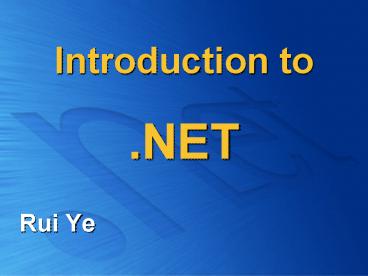Introduction to .NET - PowerPoint PPT Presentation
Title:
Introduction to .NET
Description:
This new generation of technology is based on Web services---small building ... Web Forms. Common Language Specification. VB. C . C#. JScript ... – PowerPoint PPT presentation
Number of Views:223
Avg rating:3.0/5.0
Title: Introduction to .NET
1
Introduction to .NET
- Rui Ye
2
Agenda
- What is Microsoft .NET
- The basic elements of .NET
- What are Web services
- XML Web services basics
- What is .NET Framework
- Basic components of the .NET Framework
- Benefits of the .NET Framework
- Visual Studio .NET
- Comparing .NET with J2EE
3
What is Microsoft .NET
- Microsoft .NET is a set of software technologies
for connecting information, people, systems, and
devices. This new generation of technology is
based on Web services---small building-block
applications that can connect to each other as
well as to other, larger applications over the
Internet.
4
The basic elements of .NET
- Smart Clients
- Web Services
- Servers
- Developer tools
5
What are Web services
- The foundation of .NET is Web services.
- Web services allow applications to share data.
- Web services are discrete units of code each
handles a limited set of tasks. - They are based on XML, the universal language of
Internet data exchange, and can be called across
platforms and operating systems, regardless of
programming language.
6
XML Web services basics
- SOAP---Simple Object Access Protocol.
- WSDL---Web Services Description
- Language
- UDDI---Universal Discovery Description
- and Integration
7
XML Web Services basics (cont.)
8
What is .NET Framework
- The .NET Framework is an important new component
of the Windows family of operating systems. It is
the foundation of the next generation of
Windows-based applications that are easier to
build, deploy, and integrate with other networked
systems.
9
What is .NET Framework (cont.)
VB
C
C
JScript
Common Language Specification
Web Forms
XML Web services
Windows Forms
Data and XML
Base Class Library
CLR
10
Basic components of the .NET Framework
- The .Net Framework consists of two main parts
- Common language runtime
- Provides the common services for .NET
Framework applications. Over 27 languages
supports today. - .NET Framework class library(Three key
components) - ASP .NET Windows Forms ADO .NET.
11
CLR Execution model
Source code
VB
C
C
Unmanaged Component
Compiler
Compiler
Compiler
Managed code
Assembly IL Code
Assembly IL Code
Assembly IL Code
Common Language Runtime
Native Code
Operating System Services
12
.NET Framework class library
- ASP .NET to help build Web applications and Web
services. - Windows Forms to facilitate smart client user
interface development. - ADO .NET to help connect applications to
databases.
13
.NET Framework class library (cont.)
14
Benefits of the .NET Framework
- Helps IT professionals better integrate existing
systems with its native support for Web services. - Assists with deployment of software to both users
and Web servers. - Facilitates the development of software with
improved reliability, scalability, performance,
and security.
15
Benefits of the .NET Framework (cont.)
- Helps developers be more productive by
- 1. Making it easier for them to reuse
existing code. - 2. Enabling them to more easily integrate
components written in any of the more than 20
supported programming languages. - 3.Helping them more easily build software
for a wide range of devices using same skills and
tools.
16
Visual Studio .NET
- Integrated Development Environment
- Visual Basic.NET
- Many language enhancements
- Inheritance,Overloading, Free Threading
- Visual C
- Integration with .NET Framework with managed
extensions (classes) - C
- New development language
- Based on C/C with Garbage Collection/Memory
Management
17
Visual Studio .NET Features
- Single IDE for all Languages
- Server Explorer
- Event Viewer, Message Queues, Services
- SQL Databases, Data Connection, Etc.
- Integrated IE Browser
- HTML/XML Editors
- Macros/Macro Explorer
- Solution Explorer
- Tabbed Documents
- Dynamic Help
- Common Forms Editor
- VB.NET, C, and C
18
Comparing .NET with J2EE
- .NET is a product, Java and J2EE is a
specification - Both address the web (among other things)
- The rule-of-thumb Java is platform-independent,.
NET is language independent - must be considered carefully
- ECMA works on the standardization of C and parts
of .NET - Other languages can be compiled to the JVM
19
Comparing .NET with J2EE
- Windows Applications are probably better done
with .NET than Java - Java should be used when platform -independence
is necessary - Java is more mature
- Both can be used for web services - .NET is
nicer, J2EE is more scalable
20
Reference
- Microsoft Corporation, 2002 MCAD/MCSD Self-Paced
Training Kit Developing Web Applications with
Microsoft Visual Basic .NET and Microsoft Visual
C .NET - Microsoft Corporation, 2002 MCAD/MCSD Self-Paced
Training Kit Developing XML Web Services and
Server Components with Microsoft Visual Basic
.NET and Microsoft Visual C .NET - http//www.microsoft.com/net
- http//msdn.microsoft.com/net
- http//www.voelter.de/data/presentations/J2EE_vs_N
ET_MV.ppt
21
Thanks
- Questions?































